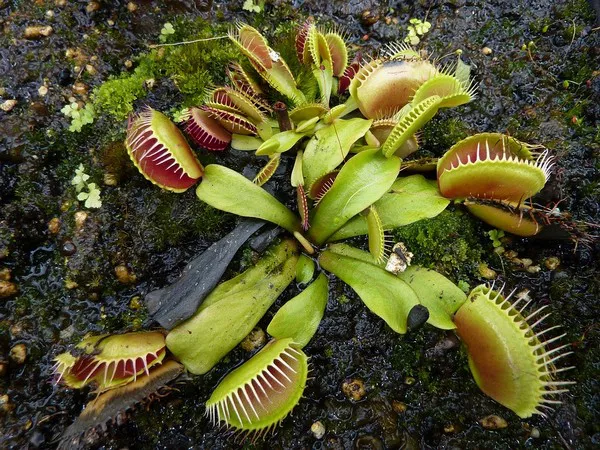Carnivorous plants, often regarded as nature’s marvels, have captivated botanists and enthusiasts alike for centuries. These unique organisms have evolved ingenious mechanisms to capture and digest prey, enabling them to thrive in nutrient-poor environments. While carnivorous plants are relatively rare compared to their non-carnivorous counterparts, they boast an astonishing diversity of forms, habitats, and hunting strategies.
In this comprehensive exploration, we delve into the world of carnivorous plants, shedding light on some of the most common and intriguing species. From the iconic Venus flytrap to the elegant pitcher plants, we unravel the mysteries of these captivating organisms and explore their adaptations, habitats, and cultivation requirements.
Most Common Carnivorous Plant Varieties
1. Venus Flytrap (Dionaea muscipula)
The Venus flytrap is perhaps the most iconic and recognizable carnivorous plant, renowned for its intricate trapping mechanism and rapid movements. Native to the wetlands of North and South Carolina in the United States, the Venus flytrap lures unsuspecting prey with its vibrant red traps, which bear trigger-sensitive hairs.
When an insect or spider brushes against these trigger hairs, the trap snaps shut with lightning speed, trapping the prey inside. Digestive enzymes are then secreted to break down the captured insect, providing the plant with vital nutrients.
Care Tips:
Plant in a well-draining soil mixture consisting of sphagnum moss and perlite.
Provide ample sunlight, as Venus flytraps require at least 6 hours of direct sunlight daily.
Keep the soil consistently moist with distilled water or rainwater, avoiding tap water, which may contain minerals harmful to the plant.
Mimic the plant’s natural habitat by maintaining high humidity levels and avoiding fertilization.
2. Pitcher Plants (Family: Nepenthaceae, Sarraceniaceae)
Pitcher plants encompass several genera within the Nepenthaceae and Sarraceniaceae families, each characterized by their distinctive pitcher-shaped traps. These plants are found in a variety of habitats, including bogs, swamps, and rainforests, where they thrive in nutrient-poor soils.
The pitcher-shaped leaves of these plants are modified into elaborate traps, which are filled with a liquid digestive enzyme solution. Prey, attracted by nectar secretions and vibrant colors, fall into the pitchers and are unable to escape. Over time, the trapped insects are broken down by enzymes, providing the plant with essential nutrients.
Common genera of pitcher plants include Nepenthes, native to tropical regions of Asia and Australia, and Sarracenia, found primarily in North America.
Care Tips:
Plant in a well-draining soil mixture consisting of sphagnum moss, perlite, and sand.
Provide bright, indirect sunlight for optimal growth.
Keep the pitchers filled with distilled water or rainwater to maintain humidity levels and prevent the traps from drying out.
Avoid fertilization, as pitcher plants are adapted to nutrient-poor environments and may be sensitive to excess nutrients.
3. Sundews (Genus: Drosera)
Sundews, members of the genus Drosera, are characterized by their sticky glandular hairs, which secrete a viscous mucilage to ensnare prey. Found on every continent except Antarctica, sundews inhabit a diverse range of habitats, from wetlands and bogs to sand dunes and forests.
These carnivorous plants use their tentacle-like leaves to capture insects, which become trapped in the adhesive droplets. Enzymes released by the plant digest the prey, allowing the sundew to absorb nutrients directly through its leaves.
Sundews exhibit a remarkable diversity of species, ranging from tiny rosettes to sprawling ground covers and towering erect forms.
Care Tips:
Plant in a well-draining soil mixture consisting of peat moss and perlite.
Provide ample sunlight, as sundews require bright, indirect light to thrive.
Keep the soil consistently moist with distilled water or rainwater, avoiding minerals found in tap water.
Mimic the plant’s natural habitat by maintaining high humidity levels and avoiding fertilization.
4. Bladderworts (Genus: Utricularia)
Bladderworts, members of the genus Utricularia, are aquatic or semi-aquatic carnivorous plants known for their bladder-like traps. Found in freshwater habitats worldwide, including ponds, lakes, and streams, bladderworts are highly specialized predators capable of capturing a wide range of aquatic organisms.
The bladder traps of these plants are equipped with trigger hairs that respond to the slightest touch, causing the trap to rapidly inflate and suck in water along with any nearby prey. Once inside the bladder, the prey is digested, and nutrients are absorbed by the plant.
Bladderworts also produce delicate, colorful flowers that add to their allure and beauty.
Care Tips:
Plant in a shallow container filled with a mixture of peat moss and sand, keeping the soil submerged in water.
Provide bright, indirect sunlight for optimal growth.
Maintain clean, oxygenated water to prevent the growth of algae and ensure the health of the bladderworts.
Avoid fertilization, as bladderworts are adapted to nutrient-poor environments and may be sensitive to excess nutrients.
5. Cobra Lily (Darlingtonia californica)
The cobra lily, or California pitcher plant (Darlingtonia californica), is a fascinating carnivorous plant native to the Pacific Northwest region of North America. Unlike traditional pitcher plants, the cobra lily features tubular, hooded leaves that resemble the head of a striking cobra.
Prey, attracted by the plant’s nectar and vibrant colors, enter the tubular leaves and become disoriented by the translucent windows, which allow sunlight to filter through. The prey then fall into the chamber below, where they are ensnared and digested by digestive enzymes.
Cobra lilies are typically found in wet, boggy habitats, where they thrive in nutrient-poor soils.
Care Tips:
Plant in a mixture of sphagnum moss and perlite in a container with good drainage.
Provide bright, indirect sunlight or dappled shade, as cobra lilies prefer partial sun.
Keep the soil consistently moist with distilled water or rainwater, avoiding minerals found in tap water.
Mimic the plant’s natural habitat by maintaining high humidity levels and avoiding fertilization.
See Also: 7 Most Nutritious Vegetables: Things You Need To Know
Conclusion
Carnivorous plants are a testament to nature’s ingenuity and adaptability, showcasing a diverse array of trapping mechanisms, habitats, and adaptations. From the iconic Venus flytrap to the elegant pitcher plants and delicate sundews, these remarkable organisms continue to fascinate and inspire botanists, gardeners, and enthusiasts around the world.
By understanding the unique characteristics and care requirements of carnivorous plants, enthusiasts can cultivate thriving specimens and appreciate the wonder of these extraordinary organisms. Whether grown indoors or outdoors, carnivorous plants offer a fascinating glimpse into the intricate web of life and the remarkable adaptations that enable plants to thrive in even the most challenging environments.
You Might Be Interested In:


























